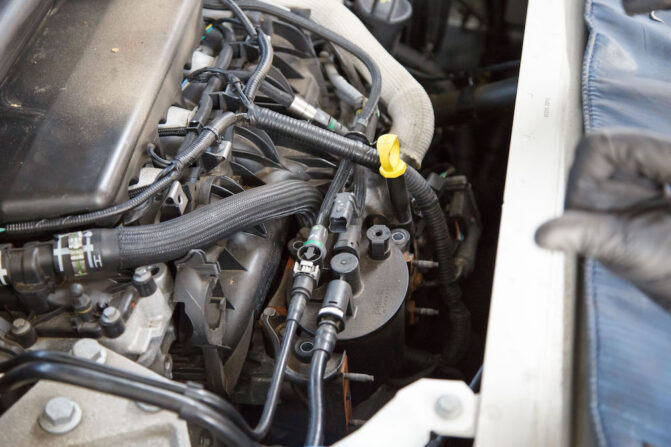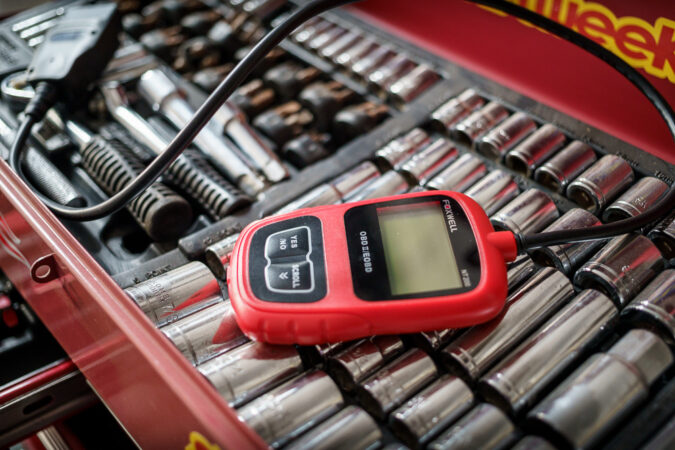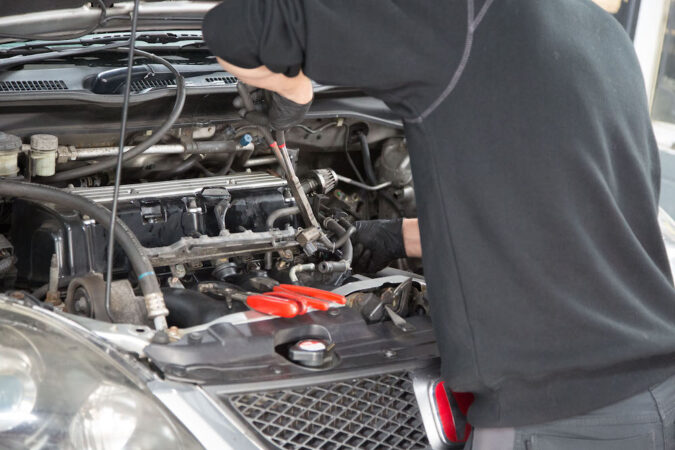All vehicles are equipped with an Evaporation Emission Control (EVAP) system specially designed to prevent toxins from being released into the air. Opening and closing the gas cap traps fuel and its toxins inside. This is important because fuel vapors contain a variety of hydrocarbons. Hydrocarbons from smog when they react with air and sunlight. It’s for that reason why the P0446 Toyota code matters.
Gasoline evaporates so quickly that if the fuel system is open to the atmosphere, the vehicle can be contaminated 24 hours a day, even when it is not on. These uncontrolled evaporative emissions account for up to 20% of the pollution produced by the vehicle.
Essentially, an EVAP system is a collection of components that work together to prevent fuel vapors from entering the atmosphere. Although system designs vary, the key components found in EVAP systems typically include gas tanks, gas caps, vent valves, purge valves, and canisters.
When the engine is stopped, fuel vapors are trapped in the canister rather than escaping to the atmosphere. When the engine is running and the proper conditions are met, the purge valve opens and trapped fuel vapor enters the engine and burns during the normal combustion process.
The vent valve for fresh air in the charcoal canister is normally open. But when your car’s computer wants to check the EVAP system for leaks, it tells the electronically controlled vent valve to close and seal everything. The system can then run a self-test.
- Car Diagnostics
- The Problem
- Sensor Diagram
- Causes
- Symptoms
- Diagnosing
- Replacement Cost
- Conclusion
- F.A.Q
Car Diagnostics
As mentioned earlier, bleed valves are normally open, so electrical issues usually do not produce P0446 on most platforms. In these cases, the vent valve remains mechanically open and always vents the canister. P0446 is a universal OBDII trouble code. This means that regardless of which make or model of vehicle, the code will mean the same thing. However, we will be focusing mainly on Toyota vehicles affected by this issue in this article.
Before we get into the more complicated things like the meaning of the P0446 Toyota trouble code, let’s first learn some basics of car diagnostics. I think there are many people who are not interested in cars and are just starting out. I need a good introduction to this topic. If you feel like you’re working, you can move on to the next chapter. If not, stick with us for a moment.
However, when diagnosing a car, it is important to start thinking like a technician. Diagnosis is not merely removing the wheels and applying the brakes. When you try to solve a problem, you have to think differently.
Evaporative Emission System Vent Control Circuit
Code P0446, also known as a malfunction of the Evaporation Emission Control System (EVAP) vent control circuit, indicates that the car’s computer has detected (or believes) a problem with the operation of the vent valve or the EVAP solenoid in the EVAP system.
The car’s computer controls the vent valve (and the purge valve as well). In addition, the computer monitors the valve and its control circuitry for problems. Code P0446 may indicate that an electrical failure has been detected in either the bleed valve itself or its control circuit.
The description of the failure varies from one car manufacturer to another, but one common thing is that the P0446 code does not directly indicate the defective part. Some testing may be required to find the faulty component.
As mentioned earlier, bleed valves are normally open, so electrical issues usually do not produce P0446 on most platforms. In these cases, the vent valve remains mechanically open and always vents the canister. It can then set off a different code, such as P0455. P0446 is likely to be a mechanically clogged closed breather valve or sludge nest in the breather. However, this also depends on the model year, make, and model of the vehicle.
P0446 can be a serious problem. To make a correct diagnosis, you need to investigate all possible causes. If you don’t have enough experience and skills to repair a do-it-yourself car, consider taking your car to a professional auto mechanic. If you still want to try the diagnostic process, the following detailed explanation of the system may help you understand the issue better.
EVAP System Diagram
The Evaporation Emission System (EVAP) is designed to store and dispose of fuel vapor before it is released into the atmosphere. Not only does this protect the environment, but it also protects fuel efficiency and prevents the odor of gasoline from the cabin. Therefore, these systems are basically designed to store and dispose of fuel vapors.
The Evaporation Emission Control System (EVAP) prevents fuel vapor from escaping into the atmosphere from the fuel tank. Fuel vapor from the fuel tank is trapped in the evaporation emission canister. The charcoal canister is filled with small activated carbon pellets that absorb and store trapped fuel vapor.
There are many different types of EVAP systems, but the standard system consists of a fuel tank, gas cap, liquid vapor, fuel tank pressure sensor, separator, evaporator canister, and a series of hoses and valves. These components work together to remove harmful hydrocarbons.
When the fuel in the gas tank evaporates, harmful gas is carried to the charcoal canister at the front of the car. When the air-fuel mixture becomes normal, it is returned to the engine. After this process, the valve creates a vacuum that draws trapped fuel vapor into the engine. These vapors combine with the fresh air from the built-in vents and valves for more efficient combustion.
How Does The EVAP System Works?
This process is mechanically or computer-controlled, depending on the age and type of vehicle. Due to a large number of moving parts in a sealed system, EVAP systems are at risk of failure or leakage over time. These errors turn on the check engine light on the dashboard.
Different leaks have different cords, but loose gas caps are most common. Leaks can be difficult to spot because pin-sized holes can trigger the cord. Technicians use scanning tools, smoke machines, and other parts to find leaks. A bad EVAP system can cause problems such as clogging of vents and poor purge flow, as well as leaks. Pin-sized holes can complement the cord and make it difficult to find leaks.
If the engine is running and other conditions permit, the fuel vapor is purged from the canister to the engine intake and burned there. Bleed control valves are usually mounted behind cars and trucks. Near or above the charcoal canister.
EVAP systems usually do not require maintenance, but if they fail, the check engine light will come on and the vehicle may not be able to pass the OBDII plug-in emission test.
OBDII EVAP monitors since 1996 perform diagnostic self-tests to detect fuel vapor leaks, and if they detect anything (including loose or missing gas caps), they set a trouble code and turn on the check engine light. Turn it on. However, EVAP monitoring is only performed under certain operating conditions. This can cause problems for the vehicle owner if the vehicle needs to undergo an OBD II plug-in emission test and the monitor has not completed it.
Purge Valve
Purge control valves are electric solenoids/valves controlled by the engine computer (ECM). The bleed control valve is normally open. Controls the flow of air to the canister. When the ECM performs a leak test on the EVAP system, the purge control valve closes.
During the leak test, the ECM seals the EVAP system by closing both the bleed control valve and the purge control valve (solenoid). Once the EVAP system is sealed, the ECM monitors the vacuum or pressure of the EVAP system. If the EVAP system does not hold a vacuum or pressure, the ECM will detect an EVAP leak (such as the P0442 BMW error code).
The purge valve acts as an outlet to the engine intake. Trapped fuel vapor can only pass through the bleed valve if the ECM has ordered the bleed control valve to allow air to pass through. The P0446 code is displayed when the bleed control valve is malfunctioning.
Causes Of The P0446 Toyota Trouble Code
Vapor Canister Purge Valve – One of the most common causes of the P0446 code is the trapped fuel vapor canister purge valve. The replacement is very easy. There are some clips that need to be found and removed.
EVAP System Hose – A hose that carries fuel vapor from the fuel tank to the intake manifold can leak. This gives rise to the P0446 code. Look for either a tear or a hole in it.
Faulty Charcoal Canister – A bad charcoal canister is often the cause of P0446.
Fuel Tank Sending Unit – The fuel tank sender unit may fail. This can ruin the pressure on the line and throw the code.
Fuel Cap – A bad fuel cap can cause the code to be thrown for sure. In most cases, you will see a message informing you that the gas cap is on but off. Obtaining this message and P0446 will save you a lot of time and money in replacing the gas cap and checking if the gas problem is solved.
Fuel Filler Neck – Often there is a gasket where the fuel filler neck connects to the gas tank. This seal can dry out, especially in vehicles that spend time in dry climates. When it dries, the fuel tank can no longer hold pressure.
Canister Vent Valve Solenoid Symptoms
The P0446 Toyota trouble code usually has no noticeable symptoms. The service engine light will come on soon, but usually, that’s it. You may notice a slight decline in the fuel economy (which is unlikely). P0446 can also cause a slight odor of gas (which is also very unlikely). This is because it is related to systems that process fuel vapors, including the EVAP canister vent solenoid.
P0446 Toyota Camry
The Toyota Camry has been the car of choice for many families for many years. It offers spacious interiors, competitive fuel economy, and excellent reliability. Toyota cars have been very successful since their launch in 1983 and are still one of the best-selling cars. However, the Toyota Camry is found to be most affected by the P0446 Toyota trouble code and older Camrys are more prone to this error. Especially the Toyota Camry models produced between 1997 and 2001.
P0446 Toyota 4Runner
When it comes to SUVs, the Toyota 4Runner is one of the most popular options in the world. But that doesn’t just mean something new. Thanks to Toyota’s outstanding reliability, 4Runner usually lasts a long time. But P0446 is a common trouble code for the Toyota 4Runner also and it often appears with other codes, such as P0420, PO441 code, or PO440.
P0446 Toyota Tacoma
Toyota Tacoma is one of the most popular light trucks in the United States. There are no terrains that cannot be crossed, and its features make you and your passengers safe and entertaining on the road. It’s a reliable truck, but it’s not without its problems and trouble. This mid-size truck from Toyota is another popular victim of the P0446 trouble code.
Diagnosing The P0446 Toyota Trouble Code
Step 1: Inspecting The Gas Cap And EVAP
Of all the parts listed above, the best would be to start checking from the gas cap and work your way up to the fuel tank. Since the gas cap is the cheapest and easiest to replace the component, it would be wise to start with it.
Examine the gas cap to see if it is loose or damaged. If the gas cap is loose, tighten the gas cap to clear the cord. Inspect the gas cap for physical damage or wear. However, keep in mind that damage to the fuel cap and deterioration of the components are not always obvious. If the gas cap is not loose and there are no signs of failure, try replacing the gas cap and clearing the cord.
The next step is to check the EVAP control. They may be sticky, clogged, or have an internal solenoid failure. There are several ways to check the controls. Try blowing off the bleed control valve. If it does not open, it may be sticky or clogged.
Step 2: Check For OBD Codes Other Than P0446 Toyota
The mechanic usually checks for other trouble codes. The more error codes you have, the easier it is to diagnose the problem. When they appear together in a particular combination, there are often very few conditions that can trigger any combination of code at the same time.
After identifying the trouble code displayed on P0446, the mechanic usually inspects the EVAP system. This includes flush valves, lines, and canisters. The mechanic will check the gas cap to make sure it can withstand the pressure. If you get an alert that the gas cap is on but off, replacing the gas cap may clear this code.
The tank pressure is checked and monitored. After the above checks and corrections, the mechanic will perform two tests. Smoke testing uses scan tools to verify that EVAP solenoids and valves are functioning correctly.
Step 3: Test The Bleed Valve Circuit
The P0446 code isn’t usually an imminent threat to vehicle drivability. Indeed, if the service engine lights up quickly, it’s good to handle it as soon as possible. Often accompanied by P0442 (as with the P0442 code Chevy Silverado). P0420 is another common trouble code that often accompanies P0446.
To solve this problem at Toyota, you need to test the bleed valve circuit from the ECM to the valve to make sure it closes and powers when the key is on (the engine is running). Then, check the resistance of the control circuit against the information in the manual. When everything is checked out, replace the breather bulb and reset the ECM / PCM code.
If other codes are also triggered, check them before replacing the bleeder valve to make sure the problem is not further above the line and is not causing P0441 as a peripheral trigger than the main problem.
Step 4: Refer To Toyota’s Service Bulletin
A service bulletin was issued by Toyota – #EG013-03 to fix problems with evaporation emission systems and issued codes P0440, P0441, or P0446. This security bulletin applies to vehicles including the Toyota Camry, 4Runner, and Tacoma. But its scope also depends on the vehicle’s production date.
While driving, the owner may see the check engine light on, and the computer saves one of these P0440, P0441, or P0446 trouble codes. This issue is due to the canister’s closed valve vacuum switching valve (CCV VSV) not functioning. The CCV assembly process has been modified to fix this condition. You can buy the original Toyota CCV valve in a new style. If you still have the code, continue to check if the canister is cracked or leaking.
Many Toyota vehicles including Camry, Corolla, Avalon, RAV4, Tacoma, and Tercel, as well as Lexus RX 300, ES 300, SC 400, LS 400, and LX 450 with the code P0446, the repair often involves replacing the EVAP vacuum switching valve (VSV) and charcoal canister as an assembly. Along with this, all the involved vacuum hoses are also cleaned or replaced.
In a nutshell, the most common fixes for the P0446 Toyota trouble code include the replacement of the gas cap/EVAP line/charcoal canister or the fuel tank itself.
Replace Evaporative Emissions Purge Control Valve
The P0446 code needs to be properly diagnosed at your dealer or car repair shop. This usually costs $75 to $150, depending on the labor price of the store. Many, if not most, stores charge this diagnostic fee for all required repairs when requesting repairs.
Gas caps are relatively inexpensive and are often the solution with code P0446. As is often the case when the canister assembly needs to be replaced, repairs can cost up to $600-800, including diagnostics. Charcoal canister assemblies are not cheap parts.
However, often the EVAP Vacuum Shift Valve (VSV) is the part that fails. EVAP VSV is much cheaper than the entire assembly. We recommend that you start testing EVAP VSV. It is attached to the bracket of the canister. It looks like a small cylindrical solenoid with a two-wire connector and a vacuum line connected.
EVAP VSV can be tested with a 12V power supply. The operating VSV will make a clicking sound when a voltage is applied, switching between a closed airflow and an open airflow. If the EVAP VSV is defective, replacing only that part may solve the problem.
Facts about Toyota’s Evaporative Emissions System and Troubleshooting DTC P0446:
- Testing Toyota’s evaporative emissions systems is a complex topic, and DTC P0446 may be caused by two different actuators.
- Two actuators are involved in the system: the Canister Close Valve (CCV) and the Bypass Solenoid Valve, which are both solenoid-operated valves.
- The CCV and Bypass Valve have some similarities, including being energized by the ECM by grounding, with full on or off electrically, and only for a short period during the EVAP monitor.
- The CCV is normally open mechanically and serves as the back door of the intrusive EVAP system, while the bypass valve is normally closed mechanically and separates the canister side from the fuel tank side of the system.
- CCV is typically mounted on the air cleaner housing of a 4-cylinder Camry, while the bypass valve is situated at the end of the canister assembly.
- Failure of CCV is not common, while a stuck-closed bypass valve is a common failure in the intrusive EVAP system.
- A P0446 may be triggered by a failure in either component, but some technicians replace the CCV when the bypass valve is the actual cause.
- A modern scan tool is needed to function well on Toyota vehicles, energize any VSV in this system, and monitor the VPS sensor signal.
- Each VSV makes a pronounced click when energized, and a scan tool can only energize one of these EVAP solenoids at a time.
- A series of simple tests should confirm a stuck-closed bypass valve.
P0446 Toyota Trouble Code Conclusion
This article has covered quite a bit about the P0446 Toyota code. First, you learned the basics of car diagnosis and how to do it in a car. Next, I focused on the problem and wrote the code.
After learning the cause of this code. Similar to the symptoms associated with the EVAP system and learned how to diagnose it and fix the problem.
F.A.Qs On The P0446 Toyota Code
Here are some popular FAQs:
How To Test Purge Valve With Multimeter
After locating the purging valve, you need to disconnect and reconnect the 2-pin harness that is connecting to the device with the multimeter’s adapter cables. After this, the resistance is measured and the ideal levels should be between 22.0 ohms and 30.0 ohms.
How Do I Fix Code P0446
The P0446 code needs to be properly diagnosed at your dealer or car repair shop.
Where Is the EVAP Vent Solenoid Located
The EVAP vent solenoid is usually located underneath the vehicle, close to or at the charcoal canister near the fuel tank.
How To Test A Charcoal Canister
Look at the purge valve as the hand pump remains on. The valve should stay open, but no vacuum should leak from the canister in the process.
Can A Bad EVAP Canister Cause Misfire
The purge valve acts as an outlet to the engine intake. It allows fuel vapor to move from the charcoal canister to burn in the engine. And yes, a bad EVAP Canister could cause a misfire.
How Does A Purge Valve Work
It works by allowing fuel vapor to move from the charcoal canister to burn in the engine.





